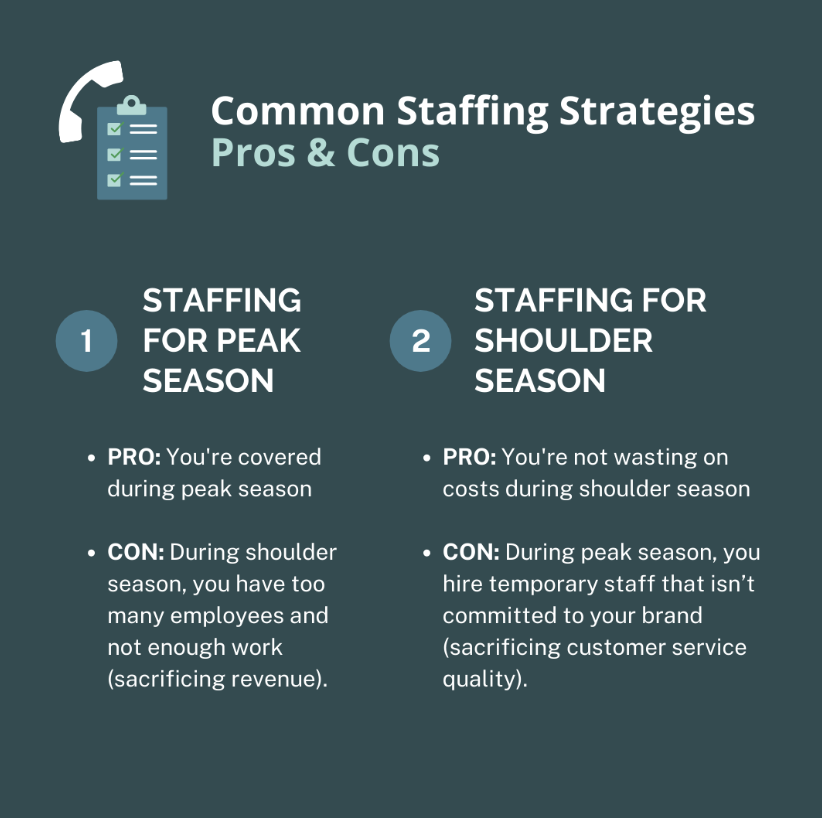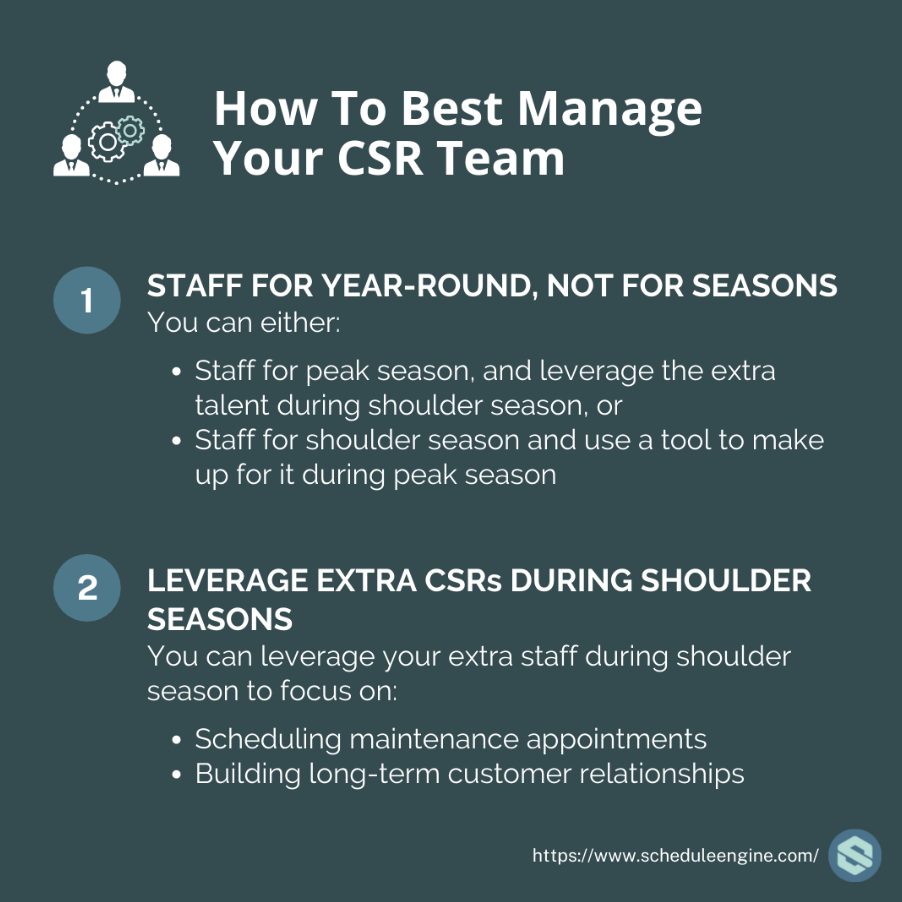When it comes to home services demand, you know the drill: you're busier when the weather acts up. In an industry reliant on weather patterns and seasonal changes, it's natural for demand to fluctuate throughout the year. Knowing how and when to adjust customer service staff sizes can be challenging and frustrating for home service companies like yours.
As the Head of Customer Success at Schedule Engine, I've noticed a thing or two about how companies handle customer service team staffing throughout the year. I've learned a lot in my role working with home service companies of all sizes across different trades. I'm here to share some of my experiences and knowledge to help you build a strategy for your staffing efforts during peak and shoulder seasons.

What Happens During Shoulder Season?
When shoulder season rolls around, you probably face significantly lower call volume than during the remainder of the year. I'd estimate that demand can fluctuate anywhere up to 50%. From a business staffing perspective, shoulder season demand dips present a critical problem. During peak season, you need a robust staff of customer service representatives to manage the high volume of incoming calls and chats. But your customer service representatives (CSRs) have fewer calls and chats to answer when demand dips off.
Common Staffing Strategies
This fluctuation often leads companies to follow one of two staffing strategies, each with its own difficulties.
Staffing for peak season is when a company hires a high number of customer service representatives to manage demand at its peak level. As a result, when shoulder season comes and demand curves off, most of the team sits idle.
The problem: You're covered during peak season, but you have too many employees and not enough work during shoulder season (and therefore, you're sacrificing profits with higher, unnecessary labor costs).
2. Staffing for Shoulder Season Season
Other companies choose to staff for shoulder season and make up for the smaller team during peak season by hiring temporary CSRs. As a result, your team size fluctuates with demand.
The problem: You're not wasting on costs during shoulder season, but you're hiring temporary staff that isn't committed or dedicated to your brand during peak season (and therefore, you're sacrificing customer service quality).
As you may be able to see, neither of these strategies is particularly effective. These strategies present an even bigger problem when extreme weather events occur. For example, what happens with an unexpected hurricane if you shrink your CSR team for shoulder season? Or a heatwave? Well, you might panic. (Or, you can follow our game-plan for extreme weather event planning and execution).

How To Best Manage Your CSR Team Throughout The Seasons
Unrelated to extreme weather events, there are a few ways that you can manage your team regularly to make up for the issues presented by common staffing strategies:
Staff for year-round, not for seasons
Staffing for year-round rather than shoulder seasons is a much better approach to staffing for your business. This strategy can mean:
Staffing for peak season, and finding ways to leverage the extra talent during shoulder season, or
Staffing for shoulder season and relying on a tool like Schedule Engine's Live Chat and Live Voice services to make up for it during peak season
By stabilizing your year-round CSR staff, you'll have better employees with better retention, leading to better performance overall—which is much more important than skimping on labor costs here and there.
-
Leverage your extra CSR staff during shoulder season
Suppose you choose to go the "staffing for peak season" route. In that case, you can leverage the extra staff you have during shoulder season to focus on other tasks such as scheduling maintenance appointments and building long-term customer relationships. You have more time and energy to nurture returning customers and improve customer retention, with limited issues answering one-off emergency calls during peak season.
How Schedule Engine Can Help
If you choose to go the "staffing for shoulder season" route, Schedule Engine is the perfect tool to support you through the peak season. Then, you can reimagine CSRs' roles to drive new business and use Schedule Engine to support it.
How?
Through our live services: Live Chat and Live Voice, you can leverage our customer service representatives (CSR) team to take your calls and chats when demand picks up. We charge our live services at a per-use rate—so you only pay for what you use. In other words, your expenses will mirror your revenue and demand, as they should.
Hear what Craig Sabol, Service Manager at our client, Presidential Heating & Air, had to say about it: "Schedule Engine has reduced the amount of inbound calls to a point where we did not have to hire a seasonal CSR as in past years. It also frees up our current CSRs to find additional business."
You can also use our Online Scheduler (in addition to our live services) and control your availability to ensure our team properly manages your demand against your availability. You can configure your availability based on the value of the job, too, so that you're able to prioritize the most high-value, emergent jobs coming in when demand is hot.
In total, Schedule Engine can help you screen out the noise and book the most valuable jobs, all while keeping the heat off of your CSR team. That way, you can confidently rely on the same CSR team year-round, leaning on us only when you need it. It's a win-win for everyone involved!
Just ask Any Hour Electric, Plumbing, Heating & Air. Any Hour has seen tremendous success with the full suite of Schedule Engine services. With an average of nearly 1,000 appointments booked across the platform each month, Any Hour leverages Schedule Engine's products and services to support their exceptional customer service with no additional lift from their team. Peak season is no problem for Any Hour with Schedule Engine's suite of solutions.
Interested in learning more about how Schedule Engine can help you manage seasonal demand fluctuations?





